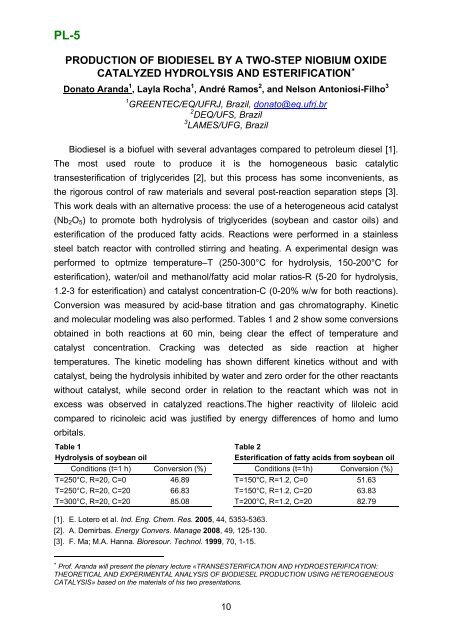Boreskov Institute of Catalysis SB RAS, Novosibirsk, Russia
Boreskov Institute of Catalysis SB RAS, Novosibirsk, Russia
Boreskov Institute of Catalysis SB RAS, Novosibirsk, Russia
- No tags were found...
Create successful ePaper yourself
Turn your PDF publications into a flip-book with our unique Google optimized e-Paper software.
PL-5PRODUCTION OF BIODIESEL BY A TWO-STEP NIOBIUM OXIDECATALYZED HYDROLYSIS AND ESTERIFICATION ∗Donato Aranda 1 , Layla Rocha 1 , André Ramos 2 , and Nelson Antoniosi-Filho 31 GREENTEC/EQ/UFRJ, Brazil, donato@eq.ufrj.br2 DEQ/UFS, Brazil3 LAMES/UFG, BrazilBiodiesel is a bi<strong>of</strong>uel with several advantages compared to petroleum diesel [1].The most used route to produce it is the homogeneous basic catalytictransesterification <strong>of</strong> triglycerides [2], but this process has some inconvenients, asthe rigorous control <strong>of</strong> raw materials and several post-reaction separation steps [3].This work deals with an alternative process: the use <strong>of</strong> a heterogeneous acid catalyst(Nb 2 O 5 ) to promote both hydrolysis <strong>of</strong> triglycerides (soybean and castor oils) andesterification <strong>of</strong> the produced fatty acids. Reactions were performed in a stainlesssteel batch reactor with controlled stirring and heating. A experimental design wasperformed to optmize temperature–T (250-300°C for hydrolysis, 150-200°C foresterification), water/oil and methanol/fatty acid molar ratios-R (5-20 for hydrolysis,1.2-3 for esterification) and catalyst concentration-C (0-20% w/w for both reactions).Conversion was measured by acid-base titration and gas chromatography. Kineticand molecular modeling was also performed. Tables 1 and 2 show some conversionsobtained in both reactions at 60 min, being clear the effect <strong>of</strong> temperature andcatalyst concentration. Cracking was detected as side reaction at highertemperatures. The kinetic modeling has shown different kinetics without and withcatalyst, being the hydrolysis inhibited by water and zero order for the other reactantswithout catalyst, while second order in relation to the reactant which was not inexcess was observed in catalyzed reactions.The higher reactivity <strong>of</strong> liloleic acidcompared to ricinoleic acid was justified by energy differences <strong>of</strong> homo and lumoorbitals.Table 1 Table 2Hydrolysis <strong>of</strong> soybean oilEsterification <strong>of</strong> fatty acids from soybean oilConditions (t=1 h) Conversion (%) Conditions (t=1h) Conversion (%)T=250°C, R=20, C=0 46.89 T=150°C, R=1.2, C=0 51.63T=250°C, R=20, C=20 66.83 T=150°C, R=1.2, C=20 63.83T=300°C, R=20, C=20 85.08 T=200°C, R=1.2, C=20 82.79[1]. E. Lotero et al. Ind. Eng. Chem. Res. 2005, 44, 5353-5363.[2]. A. Demirbas. Energy Convers. Manage 2008, 49, 125-130.[3]. F. Ma; M.A. Hanna. Bioresour. Technol. 1999, 70, 1-15.∗ Pr<strong>of</strong>. Aranda will present the plenary lecture «TRANSESTERIFICATION AND HYDROESTERIFICATION:THEORETICAL AND EXPERIMENTAL ANALYSIS OF BIODIESEL PRODUCTION USING HETEROGENEOUSCATALYSIS» based on the materials <strong>of</strong> his two presentations.10
















